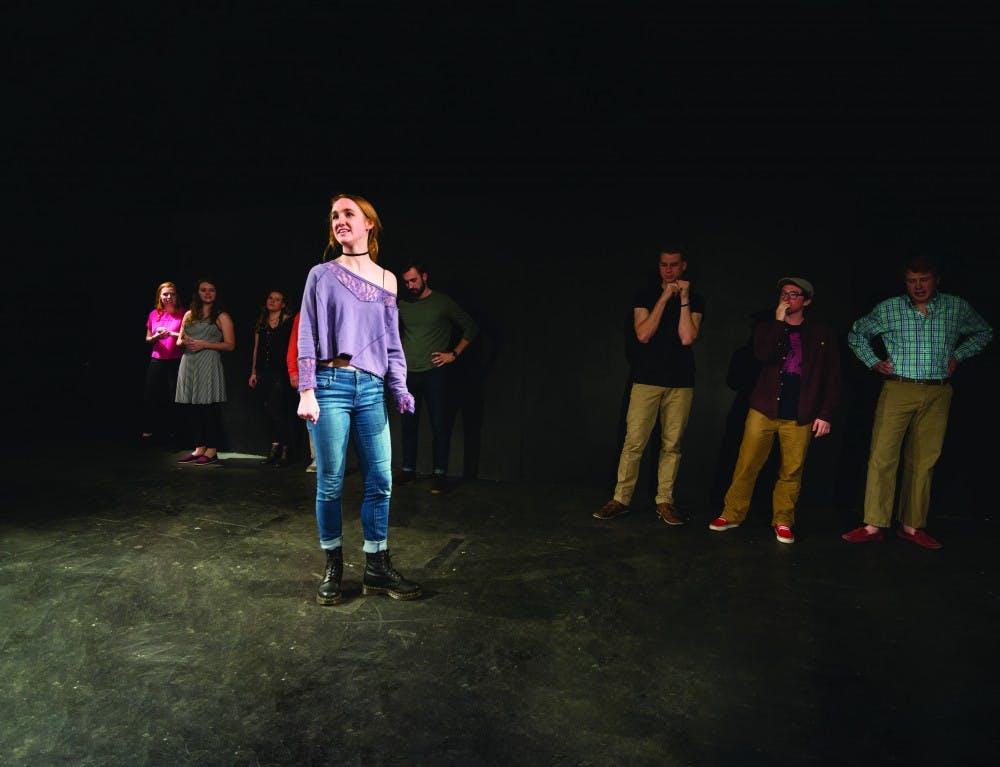To those who have never attended an improv show — it’s not just theater. It’s a thrill ride, a test of the human imagination, a sample of quick-witted snap decisions and plot building right before your very eyes. It is a show being created specifically for you, partially by you — in and only in that moment. Some of your favorite comedians probably got their start in the improv world — Amy Poehler, Tina Fey, Steve Carrell, Will Ferrell … the list goes on and on. Being an improv performer trains comedians and actors to invent and react off the top of their heads — following the rules of improv to create a story and a show where seconds before there was nothing.
Toast Improv, an improvisational group on campus, is no exception to this style of theater that is all about making it up as you go along.
“My favorite thing about improv is that you have absolutely no idea what you’re going to do before you do it,” says Allison McHugh, a Toast member. “And that can be so funny for the audience but also so funny for the cast members, because so much can come out of left field, and that allows for such a fun and on-the-fly experience.”
Toast has a couple of shows scattered throughout the semesters, and any person in attendance may be incorporated into the show itself.
When discussing audience involvement, Cala Adair, a member of Toast, says, “There are a few questions that some of the older Toast members ask to generate suggestions. For example, ‘What did I find under my bed this morning?’ or ‘Can I get a household chore?’ In a sense, we’re always working with the audience to create shows. The suggestions the audience generates fuel our creativity and provide the backbone for whatever scene we’re about to do,” she continues. “There are some games that involve more literal involvement. For example, in the game ‘Texts From A…’ an audience member volunteers to give us their phone. Two improvisers start doing a scene based off a suggestion, and one improviser can only respond by using texts sent from the audience member’s phone.”

This is a big contribution to what sets improv apart from conventional theater. It is so purely spontaneous. Actors are not learning their lines from a script but more so learning how to think quicker, how to react to an audience’s energy and how to contribute to a story and a world that may be forming in somebody else’s head entirely.
“The audience’s energy is huge,” says Andrew Freix, a four-year member of Toast. “Because if we think they are enjoying themselves, it gives us a lot of energy, and I think the overall show is heightened. One time we were in a new venue where we couldn’t hear the audience laughing, and we thought it was our worst show until everyone told us how much they enjoyed it.”
It’s important that the members of Toast all work together in order to go out on stage with no script, plot or plan for how the scene will progress at all. In a way, teamwork is a vital component of improv. The experience is not only about one actor’s performance, but also about their ability to build off of their peers, to encourage them to be creative, to “say yes.”
“The most important rule of improv is to ‘say yes’ to everything,” Adair says. “A lot of times, that attitude tends to extend to other parts of our lives. Toast is great because even if we aren’t necessarily doing improv, there’s an underlying camaraderie and hilarity that’s always present.”
“Saying yes” in improv means that whatever decisions your castmates make about the scene, as wild as they may be, you go along with them. You say yes. If they say, “Hello, giant green octopus,” you would never respond, “Why, I am not a giant green octopus. I am a small purple giraffe.” Instead, you would agree and build off of that by saying something like, “Hello to you too! My fifth tentacle is really hurting today.”
In a world where it is common for most people you walk by on any given day to be immersed in their technology, this experience is an amazing way to get out of your head, out of your phone and into the present. Marybeth Gorman Craig, a theater teacher here at USC, weaves into many of her lessons the concept of “being present.” Not only in theater, but also in life — to be fully connected with the world around you, and improv is one of the most “present” actions we have the privilege of observing. Every performer is constantly aware, constantly participating in a give-and-take with every other performer on stage, and constantly inventing and reinventing the circumstances of the world that his or her current character lives in.
Improvisers are, without a doubt, very brave. At every show, they walk on stage with only each other, their nimble minds and an audience full of ideas. Still, they manage to produce some of the funniest, cleverest and most “present” shows you will ever see. And each show is absolutely one of a kind.
p.p1 {margin: 0.0px 0.0px 0.0px 0.0px; font: 12.0px 'Helvetica Neue'; min-height: 14.0px} p.p2 {margin: 0.0px 0.0px 0.0px 0.0px; line-height: 12.1px; font: 9.0px 'Museo Sans'; color: #2c2728} p.p3 {margin: 0.0px 0.0px 0.0px 0.0px; text-align: right; line-height: 12.1px; font: 9.0px 'Museo Sans'; color: #ffffff} p.p4 {margin: 0.0px 0.0px 0.0px 0.0px; line-height: 12.1px; font: 72.0px 'Museo Sans'; color: #cdc7e3} p.p5 {margin: 0.0px 0.0px 0.0px 0.0px; line-height: 12.1px; font: 19.5px 'Museo Sans'; color: #2c2728} p.p6 {margin: 0.0px 0.0px 0.0px 0.0px; line-height: 9.1px; font: 9.0px 'Museo Sans'; color: #ffffff} span.s1 {font: 10.0px 'Helvetica Neue'}



